Shep Hyken's Blog, page 72
December 22, 2021
One Simple Idea That Can Help You Retain Your Best Employees
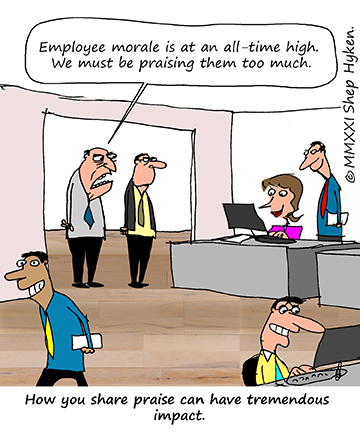 We had some great feedback on The Three N’s of Employee Fulfillment article and video. Plenty of great comments. Here’s a very short refresher in case you missed it. Leadership expert Tim Durkin shared with us that our employees want to be needed, noticed, and known. We welcome him back this week with a simple feedback technique connected to his Three N strategy that will help you motivate and keep your best employees.
We had some great feedback on The Three N’s of Employee Fulfillment article and video. Plenty of great comments. Here’s a very short refresher in case you missed it. Leadership expert Tim Durkin shared with us that our employees want to be needed, noticed, and known. We welcome him back this week with a simple feedback technique connected to his Three N strategy that will help you motivate and keep your best employees.
The short version of this is to not just praise the performer, but also the performance. It’s very simple. You not only praise your employee, but you tell them why you appreciate what they’ve done.
For example, you could say, “Great job, Bob! Thank you for your hard work.” Nobody will argue that an employee wouldn’t appreciate their boss giving a little praise. But we could do better, and it’s very simple to do so.
Tim suggests that instead of just saying, “Great job and thank you,” get a little more specific about what you’re praising. You could say, “Great job, Sarah. Thank you for your hard work. I realize you stayed late a couple of nights to get this report finished. We couldn’t have handed our proposal to the client if you didn’t put in the extra effort. Thank you again.”
Specificity is the key here. Don’t just say, “Thank you.” Expand on why you are saying, “Thank you.”
I realize this is something very small, but sometimes, as the saying goes, good things come in small packages. A slight nuance to the way you share praise can have tremendously more impact.
You can decide how much specificity you want to share. Just be careful how often you use it. You don’t want to “gush” all over your employees every time you have something nice to say to them. It diminishes the impact. To quote another old saying, “Too much of a good thing is not always a good thing.” Still, you should always praise a job well done. So, be careful and praise often, but also appropriately.
One other thought on sharing praise. It’s a motivator. People like to be told they are doing a good job. It makes them feel good. And people like to repeat what makes them feel good. So, praise away! And remember to praise both the performer and the performance.
Shep Hyken is a customer service expert, keynote speaker, and New York Times, bestselling business author. For information on The Customer Focus customer service training programs, go to www.thecustomerfocus.com. Follow on Twitter: @Hyken
customer service training programs, go to www.thecustomerfocus.com. Follow on Twitter: @Hyken
(Copyright © MMXXI, Shep Hyken)
The post One Simple Idea That Can Help You Retain Your Best Employees appeared first on Shep Hyken.
December 21, 2021
Amazing Business Radio: Dan Hill
 Customer Service Avoidance
Customer Service AvoidanceHow CX Avoidance Impacts Customers, Employees, and Brands
Shep Hyken interviews Dan Hill, founder of Sensory Logic, Inc. and a pioneer of using facial coding in business to capture and quantify consumer responses. He is the author of nine books including his latest, Blah, Blah, Blah: A Snarky Guide to Office Lingo. They discuss how to use technology and staff the customer service department to be effective throughout the entire customer journey.






 Top Takeaways:
Top Takeaways:Learn about “customer avoidance” and why it happens.
In the age of digital transformation, companies must find ways to eliminate customer service and experience avoidance and create a seamless customer experience with technology and customer relationships.
When customers call companies, one of the first things that they hear is “Your call is very important to us”, followed by a hold tone. Customers want to feel like they are moving towards progress when they are calling about a problem. When they don’t feel that they are progressing to a solution, customers will feel anger towards customer service representatives and ultimately, the brand.
Companies avoid engaging with their customers for the following reasons:
To limit their cost.To limit the time taken by their staff in interacting with customers.To avoid revealing that their staff is not well-trained or prepared to field questions.Companies sometimes become enamored with the technology. They use it as a shield to avoid interaction with their customers. When this happens, it negatively affects the brand and the whole value proposition. Dan provides some insights on how to restore the customers’ confidence in the organization:
Companies must use technology to facilitate collaboration, not to replace human-to-human contact.The transition from chatbots or any type of automation must be seamless. When the customer is connected to the frontline, they should not have to repeat their story.Frontline employees need to be knowledgeable enough to answer questions and give customers the confidence that they are progressing to a solution.For more insights from Dan Hill, listen to the full episode!Quotes:“About 25% of managers are believed to be bullies. If people are feeling bullied or oppressed, that’s going to translate in how they relate to their colleagues and their customers.”
“Sometimes technology is not the bridge to connect us but a shield to block us and keep us away from our customers.”
“Transfer more people to customer service instead of hiring. Put people who already take pride in the organization that they work for and are knowledgeable about the company’s operations.”
“Emotional Intelligence provides a 6% edge. Hire people that can provide immediate solutions to what customers are calling about as well as restore positive feelings towards your brand.”
About:Dan Hill, Ph.D., is the author of nine books, including Emotionomics and Blah, Blah, Blah: A Snarky Guide to Office Lingo. He is the founder of Sensory Logic, Inc. whose clients represent over 50% of the world’s top 100 advertisers.
Shep Hyken is a customer service and experience expert, New York Times bestselling author, award-winning keynote speaker, and your host of Amazing Business Radio.
This episode of Amazing Business Radio with Shep Hyken answers the following questions … and more:
What is customer avoidance?How do you deal with call avoidance?Can we turn customer service from a cost center into a profit center?How might CX be staffed differently?How can C-suite get more involved in the CX storyline?The post Amazing Business Radio: Dan Hill appeared first on Shep Hyken.
December 20, 2021
5 Top Customer Service Articles of the Week 12-20-2021
Each week I read many customer service and customer experience articles from various resources. Here are my top five picks from last week. I have added my comment about each article and would like to hear what you think too.
Talkdesk Research Reveals the Role of Customer Service in Driving Consumer Loyalty Will Expand Beyond Support(Martech Series) Organizations have emerging opportunities – and threats – to consider as consumer loyalty increasingly takes into account broader relationships to companies.
My Comment: Pay close attention to these findings. Three important points to this very on-point article. 1. A good customer support experience drives loyalty. (We knew that!) 2. A cause or social issue contributes to the customer experience, especially with Gen Z. 3. Proactive customer engagement from the contact center will turn reactive customer support agents into brand ambassadors.
AJ Brooks of Tulane University: 5 Ways To Create a Wow! Customer Experience by Tyler Gallagher(Authority Magazine) As part of my series about the five things a business should do to create a Wow! customer experience, I had the pleasure of interviewing A.J. Brooks, Lecturer; Assistant Director of Entrepreneurial Hospitality, A.B. Freeman School of Business at Tulane University.
My Comment: A WOW customer experience is not always about being over the top. This Tulane University professor’s take on WOW is worth noting: “Just little things outside the realm of expectation.” These “little things” show you care about the customer and are paying attention. Anyone can focus on managing the “little things.”
Why Current CX Is Broken and How To Fix It by Tim Harnett(CMSWire) The only way to fix CX and give customers the experience they deserve is with a precise blend of Conversational AI and humans.
My Comment: This is a short article and it cuts straight to the point. Using a few stats and facts, that point is that customer service needs to improve, and if you’re not nailing it, don’t be surprised if your customer walks. 92% of consumers believe customer service needs improvement, and 80% have defected after one bad experience.
Nine Impactful Customer Service Lessons That Can Change Your Business Approach by YEC Expert Panel(Forbes) During their business journeys, the members of Young Entrepreneur Council have learned some unexpected lessons about making customers happy. Nine of them shared surprising tidbits they’ve picked up along the way that can help businesses revamp and improve their existing customer service infrastructure.
My Comment: Here is a “back to basics” article with nine important and foundational concepts to improve your customer service, starting with one of my favorites: The customer is NOT always right! My take on it is a little different, but I’ll still take this explanation of this important concept. Take a look at this list and choose two or three to bring up at your next team meeting.
The 5 Customer Experience Waves You Should Be Ready to Ride in 2022 By Mazen Ghalayini(CMSWire) While managing through the unexpected is important, it’s prudent to stay focused on the future and what we know is coming.
My Comment: Are you ready for 2022, at least for your CX strategy? This article emphasizes the importance of talent, especially in the wake of employment issues. Forward thinking companies will win the “War on Talent,” take advantage of “gig economy workers,” and find ways to use creativity to differentiate themselves from the competition.
BONUS14 Best Customer Experience Books to Read in 2021 by Angela Robinson(Teambuilding) Customer experience books are guides that teach professionals how to make business transactions painless, pleasurable, and memorable for customers.
My Comment: I’m honored that our friends at Teambuilding have included one of my books, The Cult of the Customer, as one of the top customer experience books of 2021. There are some great books on this list, so if you’re still trying to decide what to get your boss or colleague for Christmas, hurry up and choose one of these books!
Shep Hyken[image error] is a customer service expert, professional speaker, and New York Times bestselling business author. Go to The Customer Focus to learn more about our customer service training programs. Follow on Twitter: @Hyken
to learn more about our customer service training programs. Follow on Twitter: @Hyken
The post 5 Top Customer Service Articles of the Week 12-20-2021 appeared first on Shep Hyken.
December 17, 2021
Guest Post: How to Make the Most of Another Unprecedented Holiday Season
This week we feature an article by Kiel Harkness, Head of Global Marketing and Business Intelligence at UPS Capital®. He writes about how SMBs can make the most of the holiday season by investing in proper protection.
When the leftover turkey has been stowed away in the fridge and the football game has wrapped up, consumers will turn their focus to their holiday spending. But unlike years past, small and medium-sized businesses (SMBs) are struggling amidst a lingering global pandemic that’s brought supply chain disruptions, rising inflation, shipping, and delivery delays, and workforce staffing shortages. This is on top of their usual tough competition against retail and e-commerce conglomerates like Walmart and Amazon.
Despite the struggles, the opportunity for SMBs to capitalize on holiday shopping remains steady. The U.S. Small Business Administration reports $20 billion of Small Business Saturday spending occurred last year, during the pandemic. Not only is there a desire to spend among consumers, but we’re seeing the holiday shopping season is critical for SMBs to meet their business goals. New findings from our UPS Capital 2021 Holiday Shipping Experience Report found that 44% of SMBs report making more than a fifth of their total annual sales from Small Business Saturday and holiday spending in general. This reflects the massive pressures on businesses to not be faltered by pandemic losses and to continue to deliver for customers.
This can be challenging for SMBs with the events that occur when products are out the door and en route to doorsteps. From porch piracy to lost cargo to damaged packages, these unprecedented events can have a drastic impact on the customer experience, and the business’s overall performance this holiday season. Here are some tips for how SMBs can invest in proper protections to make the most of this holiday season.
Protect Parcels From Your Doorstep to The Customer’sOne of the biggest roadblocks that businesses face this year is the massive disruption to the supply chain, causing goods to be delayed in production and trickling down to the consumer. Approximately 33% of SMBs are concerned about supply constraints interrupting their merchandise availability, while 68% are concerned with delivery delays.
With the fast pace of the holiday season and a sharp uptick in deliveries, it’s more likely that packages will get lost in the shuffle, damaged in transit, or even stolen off the customer’s front porch. Consumers want excellent customer support when things go wrong with their delivery, and UPS Capital’s survey reports that 35% of shoppers will be motivated to shop with an SMB, as long as they are guaranteed replacement items.
To protect both the business and the customer experience, it’s important SMBs make sure their shipments are insured for even the most unexpected events – from cargo trucks going up in flames to extreme weather, to porch piracy, insurance can provide retailers the confidence they need to quickly reship and provide a positive outcome in the wake of an issue. From the customer’s standpoint, a lack of communication, refund, or replacement items is grounds for losing their loyalty. Most SMBs, they’re often unable to eat the cost of a lost or a damaged item, making shipping insurance protections ideal for both parties.
Offer Competitive DiscountsInflation has hit everyone hard with the annual rate reaching 5.4% in 2021, almost triple what the rate was in 2019, according to the US Inflation Calculator. As a result, UPS Capital’s survey found 23% of consumers have cut back their holiday spending budget, citing inflation. SMBs share this concern, with the survey finding four in five business owners worried about what impact inflation will have on their holiday revenue.
Who doesn’t love a discount? Approximately 81% of consumers are motivated by bargain hunting during their holiday shopping. Consider a loyalty program to keep customers coming back and thanking them for their consistent support and spending, whether it’s a free gift with purchase or 20% off their next order. It may be tough this year to consider discount offerings with the rising cost of goods, but offering enticing deals can be a tried-and-true strategy for driving loyal customers to your website and turning browsers into buyers.
Refine the Return and Replacement ProcessWith the surge in e-commerce spending, returns and exchanges have become a routine part of the process. As such, consumer expectations for these policies are rising. According to UPS Capital’s survey, 82% of consumers are motivated to purchase when the business offers free returns. This can create a frictionless experience if the item doesn’t meet a customer’s needs, and help the business to compete with the seamless return processes of the big retailers like Amazon.
To create a simple process for the customer, including a return label in the original packaging. Use packaging that can be used as the return, preventing the customer from having to buy or find a new box to ship back the product. Winning over new customers isn’t an easy feat but incorporating even slight tweaks to improve the exchange and return experience can make a big difference in earning new customers and maintaining loyal ones.
Amp Up Communications When There’s a MishapUPS Capital’s survey found that over 26% of SMBs are concerned about their shipments getting lost in the shuffle, broken in transit, or stolen. So, it is critical to prepare for these situations. Amp up communication between employees and customers with a working phone number or email, as 39% of customers will shop somewhere else if they feel that communication is not up to par regarding delayed deliveries. In fact, 44% of consumers would never shop with a retailer again if there was a lack of resolution support for stolen or damaged packages.
ConclusionThis year is shaping up to be a tough year for businesses as we continue to navigate a pandemic-driven world. SMBs are already feeling the heat between supply chain rifts and inflation’s impact on holiday spending budgets. By taking these steps to increase customer satisfaction, SMBs and consumers alike can make the most of another unprecedented holiday season.
Find the insurance disclosure here: https://upscapital.com/us-product-disclosures/
Kiel Harkness, Head of Global Marketing and Business Intelligence at UPS Capital®. He manages and directs global UPS Capital Digital Marketing and Digital Properties, Channel Marketing, Business Intelligence, Product Development, Communications and Advertising, and International Field Marketing teams.
For more articles from Shep Hyken and his guest contributors go to customerserviceblog.com.
Read Shep’s latest Forbes article: Top Business Books Of 2021
The post Guest Post: How to Make the Most of Another Unprecedented Holiday Season appeared first on Shep Hyken.
December 15, 2021
Donât Cut What Is Obvious to the Customerâ¯â¯
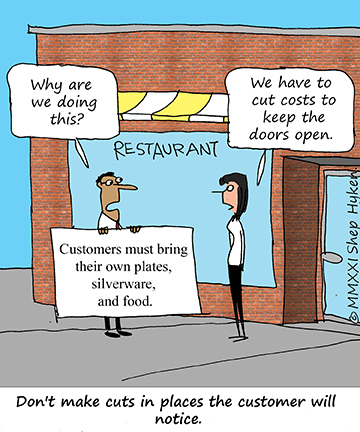 Last week I covered the concept of skimpflation. In case you missed it, the short definition is that skimpflation is the result of a labor shortage, some say due to The Great Resignation, and higher business costs that come from inflation and supply and demand issues. This translates to the customer experiencing a lower level of service, and in some cases, quality. Our colleague at Shepard Presentations refers to it as customer service on a diet.Â
Last week I covered the concept of skimpflation. In case you missed it, the short definition is that skimpflation is the result of a labor shortage, some say due to The Great Resignation, and higher business costs that come from inflation and supply and demand issues. This translates to the customer experiencing a lower level of service, and in some cases, quality. Our colleague at Shepard Presentations refers to it as customer service on a diet.Â
Unfortunately, customers in both the B2C and B2B worlds are not having the experiences theyâve come to expect from some of the companies they enjoy doing business with. Companies are forced to skimp on quality and service, and that is causing frustration at all levels. Customers donât like it. The leaders at these companies donât like it either. And employees, at least the ones who are still there, often have to take the brunt of their customersâ frustrations.Â
I keep wondering, whatâs the answer? How can companies work around skimpflation? Unfortunately, I donât have the perfect answer, but I do have an idea to avoid a big part of the problem, which is how the customer experience is being impacted.Â
Before sharing that idea, hereâs a quick, but important observation and a couple of examples. Iâm seeing that customer loyalty is up for grabs. In our research, we see customers demanding a great experience in exchange for their repeat business. Let them down, and they move on. The companies that still get this right are flourishing. Laggards are struggling at keeping both customers and employees. And skimpflation is whatâs causing the problem.Â
For example, you may have to pay more to keep your employees. This may force you to cut some employees to make up the cost difference. I hate that that would happen at all, but if you cut employees on the front line, thereâs a good chance your customers will notice. A bad experience or two, and the customers wonât come back.Â
I wrote about this example a few years ago. I went to a restaurant and ordered a popular dish, but that night it tasted different, as in ânot as good as usual.â I mentioned it to the manager and the explanation was that food costs had gone up and they were forced to substitute different â as in less expensive â ingredients. Obviously, it impacted the quality and taste of the food. Iâm not the only one who noticed. Cutting the quality of any of your products could cause customers to notice and seek out the competition, hoping for something better. Â
So here is my idea. Many businesses have to make cuts and concessions. They donât have a choice, but they do have a choice about where they cut. So, try not to cut in places the customer will notice. Â
It sounds simple, but that doesnât mean itâs easy. Itâs not. Some may even say itâs not realistic. So, hereâs a way to start. Gather your team and brainstorm the answer to this simple question: âWhere can we cut costs that our customers wonât notice?â You never know. Someone may have the perfect answer! Â
Shep Hyken is a customer service expert, keynote speaker, and New York Times, bestselling business author. For information on The Customer Focus customer service training programs, go to www.thecustomerfocus.com. Follow on Twitter: @Hyken
customer service training programs, go to www.thecustomerfocus.com. Follow on Twitter: @Hyken
(Copyright © MMXXI, Shep Hyken)
The post Donât Cut What Is Obvious to the Customerâ¯â¯ appeared first on Shep Hyken.
Don’t Cut What Is Obvious to the Customer
 Last week I covered the concept of skimpflation. In case you missed it, the short definition is that skimpflation is the result of a labor shortage, some say due to The Great Resignation, and higher business costs that come from inflation and supply and demand issues. This translates to the customer experiencing a lower level of service, and in some cases, quality. Our colleague at Shepard Presentations refers to it as customer service on a diet.
Last week I covered the concept of skimpflation. In case you missed it, the short definition is that skimpflation is the result of a labor shortage, some say due to The Great Resignation, and higher business costs that come from inflation and supply and demand issues. This translates to the customer experiencing a lower level of service, and in some cases, quality. Our colleague at Shepard Presentations refers to it as customer service on a diet.
Unfortunately, customers in both the B2C and B2B worlds are not having the experiences they’ve come to expect from some of the companies they enjoy doing business with. Companies are forced to skimp on quality and service, and that is causing frustration at all levels. Customers don’t like it. The leaders at these companies don’t like it either. And employees, at least the ones who are still there, often have to take the brunt of their customers’ frustrations.
I keep wondering, what’s the answer? How can companies work around skimpflation? Unfortunately, I don’t have the perfect answer, but I do have an idea to avoid a big part of the problem, which is how the customer experience is being impacted.
Before sharing that idea, here’s a quick, but important observation and a couple of examples. I’m seeing that customer loyalty is up for grabs. In our research, we see customers demanding a great experience in exchange for their repeat business. Let them down, and they move on. The companies that still get this right are flourishing. Laggards are struggling at keeping both customers and employees. And skimpflation is what’s causing the problem.
For example, you may have to pay more to keep your employees. This may force you to cut some employees to make up the cost difference. I hate that that would happen at all, but if you cut employees on the front line, there’s a good chance your customers will notice. A bad experience or two, and the customers won’t come back.
I wrote about this example a few years ago. I went to a restaurant and ordered a popular dish, but that night it tasted different, as in “not as good as usual.” I mentioned it to the manager and the explanation was that food costs had gone up and they were forced to substitute different – as in less expensive – ingredients. Obviously, it impacted the quality and taste of the food. I’m not the only one who noticed. Cutting the quality of any of your products could cause customers to notice and seek out the competition, hoping for something better.
So here is my idea. Many businesses have to make cuts and concessions. They don’t have a choice, but they do have a choice about where they cut. So, try not to cut in places the customer will notice.
It sounds simple, but that doesn’t mean it’s easy. It’s not. Some may even say it’s not realistic. So, here’s a way to start. Gather your team and brainstorm the answer to this simple question: “Where can we cut costs that our customers won’t notice?” You never know. Someone may have the perfect answer!
Shep Hyken is a customer service expert, keynote speaker, and New York Times, bestselling business author. For information on The Customer Focus customer service training programs, go to www.thecustomerfocus.com. Follow on Twitter: @Hyken
customer service training programs, go to www.thecustomerfocus.com. Follow on Twitter: @Hyken
(Copyright © MMXXI, Shep Hyken)
The post Don’t Cut What Is Obvious to the Customer appeared first on Shep Hyken.
December 14, 2021
Amazing Business Radio: Baker Johnson
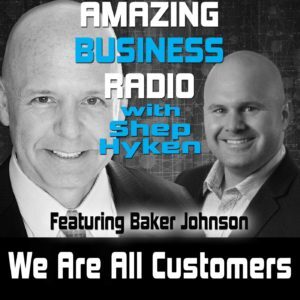 We Are All Customers
We Are All CustomersWhat Customers Expect from CX Practitioners
Shep Hyken interviews Baker Johnson, Chief Marketing Officer at UJET. They discuss how CX practitioners can put what they know about communication from their personal relationships into their customer relationships.






 Top Takeaways:
Top Takeaways:Here is something brands and even CX practitioners often forget – customers just want to get things done.
They are not thinking in terms of channels. They are not worried about what department, whether it be sales, marketing, or customer support, resolves their issues. Customers really only care about problems solved.
What do customers expect from CX practitioners?
It’s not about how many channels of communication are available. Compared to sales and marketing, the advice given to CX practitioners is always lagging. They are told to constantly add channels to meet customers where they are. But, customers don’t think in terms of channels. They just want to connect with the brand – how they want and when they want.
It’s not about departments within the organization either. Sales, marketing, and customer support departments are often fighting on who is the most influential to customer experience to gain more internal power. We have to move away from this and put customers first.
At the end of the day, we are all customers. The way that we interact in our lives is how consumers expect to interact with brands. It is also what your employees expect from you. We have to bring what we know about relationships and communication from our personal lives to our work lives and apply it to how we interact with our customers.
Quotes:“Customers shouldn’t need to pick between channels of communication. They can use them all simultaneously.”
“Consumers now have multiple options. This has brought about a shifting view towards customer experience as an investment engine.”
“Stop thinking about channels and start thing about your customers.”
“Take off your work hat, put on your real-life hat and you’ll have all the answers to what needs to be improved in customer experience.”
About:Baker Johnson, Chief Marketing Officer at UJET where he is focused on driving corporate growth by evangelizing how UJET’s ultra-modern, customer-and-user-centric approach to CX is radically disrupting the Contact Center ecosystem. He brings more than 15 years of leadership experience to the role driving branding and data-driven strategy transformations to fuel SaaS growth.
Shep Hyken is a customer service and experience expert, New York Times bestselling author, award-winning keynote speaker, and your host of Amazing Business Radio.
This episode of Amazing Business Radio with Shep Hyken answers the following questions … and more:
What do customers expect from CX practitioners?What is customer-centricity?Does omnichannel customer service work?How do you make using multiple channels seamless for the customer?How many communication channels does your business need?The post Amazing Business Radio: Baker Johnson appeared first on Shep Hyken.
December 13, 2021
Breaking News: President Biden Signs Executive Order on CX
62% of Americans don’t think the government delivers great customer service. That’s according to customer service and customer experience expert Shep Hyken. In his 2021 Customer service and CX research, he asked more than 1,000 American consumers, “Do you think the government delivers great customer service?” But there could be light at the end of the tunnel.
According to The White House briefing, President Biden is “taking decisive action to promote fiscal stewardship by improving the Government’s service delivery to its customers, the American people.” Just as the best companies and brands, known for excellent customer service, put their customers at the center of everything they do, the Executive order “directs Federal agencies to put people at the center of everything the government does.” Those people are the citizens of the United States. Specifically, the Executive Order includes 36 “commitments” to improve customer experience across 17 Federal agencies. The Order also is pushing for better service for some of what matters most to people, such as turning 65 (retiring), small business loans, and having a child. Some of the agencies and areas that the Order plans to impact include Social Security, Passport services, Internal Revenue Service, Small Business Administration for loans, Department of Veterans Affairs for benefits and health, federal student aid and more.
Hyken said, “I’m intrigued and even excited about the Government, and especially President Biden, taking a big step in improving the customer experience for the people. I believe with President Biden making this an Executive Order, this will be more than lip service. And, I’m happy to support the Government and share ideas and strategies to help them move forward with this important initiative.”
For more information about The White House Briefing, click here to access the Fact Sheet. To contact Shep Hyken for additional commentary, go to www.Hyken.com.
The post Breaking News: President Biden Signs Executive Order on CX appeared first on Shep Hyken.
5 Top Customer Service Articles of the Week 12-13-2021
Each week I read many customer service and customer experience articles from various resources. Here are my top five picks from last week. I have added my comment about each article and would like to hear what you think too.
Please Hold: How AI Is Changing Customer Service in Call Centers by Defined.ai(VentureBeat) Excellent customer service is vital to the long-term success of any business. Yet, millions of people around the world are frustrated daily as call center agents keep customers on hold for long periods, are oblivious to a customer’s distress, or are unable to provide accurate information.
My Comment: AI continues to improve. And, in the next 12-18 months you’re going to start interacting with IVA’s (Intelligent Virtual Assistants), and you may find it difficult to distinguish the AI/Digital voice experience from the human experience. This article gives us a glimpse into the benefits of AI as it applies to customer service.
Seth Godin Reveals the 1 Truth About Customer Service Most Companies Just Don’t Understand by Jeff Steen(Inc. Magazine) Ensuring your customers have the best possible experience — and come back for more — isn’t about spending more money on staff and technology. It’s about getting “service” right.
My Comment: When Seth Godin speaks (or writes), I listen (or read). In this case, it’s Jeff Steen sharing his thoughts on a Seth Godin blog post. Godin suggests that all good service requires is just a bit of energy, attention, and the right information. You don’t have to spend a lot of money to make that happen. Sounds simple, but doesn’t mean it’s easy.
Study: Bath & Body Works, Ace Hardware Among Retailers With Best Reputations by Marianne Wilson(Chain Store Age) Customer service can make — or break — the shopping experience. That’s according to reputation experience management company Reputation’s “2021 Retail Reputation Report.” The study, which examined 3.7 million shopper reviews across the U.S. and the U.K., ranks the top U.S. brands of 2021 based on shopper sentiment.
My Comment: What retailers get top marks for delivering great customer service? Bath & Body Works takes this year’s award, closely followed by Ace Hardware and then Nordstrom. No surprise with any of these “rock star” brands. The article shares the top 30 retailers. So what! It’s just a list. Yes, but it’s worth taking a few of the companies you admire on this list and digging a little deeper. A simple Google search will get you more information that may lead you to some powerful customer service and CX lessons.
What Social Media Trends Will Emerge for 2022? by Pierre DeBois(CMSWire) 2021 was a busy year for social media platforms and 2022 is shaping up to be even busier. Earlier this year I offered up some predictions on what I thought the year would hold for social media. Here’s how I see social media shaping up in 2022, along with what strategies marketers should develop for a complete customer experience.
My Comment: I haven’t included an article on VOC in quite a while, so let’s fix that. When the customer speaks, listen! That’s a version of a VOC (Voice of the Customer) program. Keep in mind that a formal VOC program is proactive, not reactive. And you need to understand the best way to listen and understand (and measure) the success you have with your customers.
Three Ways to Cultivate Loyal Customers Through Social Media by Michael Koh(Business IT) As we gear up for 2022, here are three ways you can leverage social media to take your CX to the next level and build customer loyalty for your business:
My Comment: This is a short article, but a good one. Three simple ideas on how to use social media to better engage and create customer loyalty. Here’s the first one. Respond to customers faster. So simple, but how many of you reading this experience slow response times? (Rhetorical question!) It doesn’t matter if it’s social media – or phone calls, emails, etc.
BONUSESThe 2022 Customer Experience Predictions From 10 International Top Cx Experts by Steven Van Belleghem(Steven Van Belleghem) More and more, companies are recognizing that behavior is the secret to understanding what’s happening now and in the future. It’s more than a satisfaction rating. It’s real, it’s what’s happening now, and it’s measurable. And with AI becoming more powerful, future behavior can be predicted.
My Comment: My friend and fellow customer experience expert, Steven Van Belleghem, compiled a list of ten experts (myself included) to share their customer experience (CX) predictions for 2022. It’s going to be a great year!
Customer Service Trends 2022 by ultimate.ai(ultimate.ai) Level up your customer support in 2022. In this free guide, our experts will speak to the future of customer service & show you how to stay ahead of your competition while keeping customer experiences exceptional.
My Comment: Here’s a nice report with 2022 trends/predictions focused on AI and personalization from our friends at Ultimate. AI. It’s gated, so you’ll have to give your name and email address to receive the report. You’ll be happy you did.
Shep Hyken[image error] is a customer service expert, professional speaker, and New York Times bestselling business author. Go to The Customer Focus to learn more about our customer service training programs. Follow on Twitter: @Hyken
to learn more about our customer service training programs. Follow on Twitter: @Hyken
The post 5 Top Customer Service Articles of the Week 12-13-2021 appeared first on Shep Hyken.
December 10, 2021
Guest Post: 4 Ways Media Companies Can Keep Subscribers Engaged
This week we feature an article by Alp Pekkocak who leads the industry and product marketing for Media & Entertainment at Salesforce. He shares how engaging content and personalized experiences can lead to longer-term subscriptions that have a huge impact on brands’ bottom lines.
Retaining subscribers with engaging content and personalized experiences is key to building revenue and driving long-term success.
There’s a tremendous opportunity for subscription services to deliver better experiences for their customers. Serving up what they want when they want and enabling them to share it with whom they want can lead to longer-term subscriptions that have a huge impact on brands’ bottom lines. Customer acquisition costs approximately five times more than customer retention, so what steps can companies take to keep the subscribers they already have happily engaged?
Seamlessly onboard your subscribers
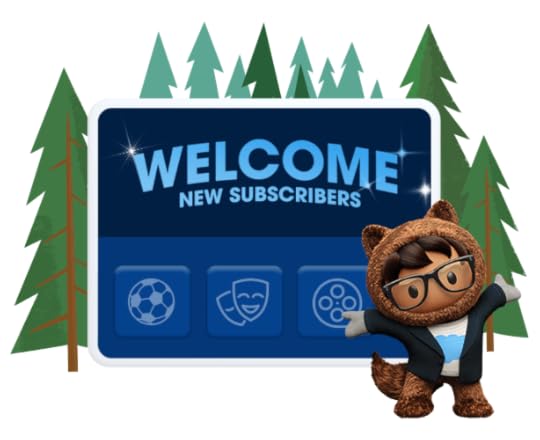
Everything from your menu of services to the checkout process and the platform introduction should be easy to read, free of clutter, and quick to navigate. An overwhelming menu of options, slow and clunky navigation, or a checkout page that keeps returning errors can turn off would-be customers. The initial experience sets the tone for how the subscriber will engage with your service moving forward and is critical in maximizing a customer’s lifetime value. The right technology can help you choreograph a delightful first impression. It can also help you gather information about your new customer that will help you shape experiences tailored to their preferences.
Stay one step ahead with answers to questions or issues that may ariseNo single service works perfectly all the time, but it’s important to plan for hiccups so that when customers encounter an issue or have a question, you can address it quickly. Self-service knowledge libraries can help customers troubleshoot on their own, while subscriber care agents available on multiple channels can help you meet your customers where they prefer to communicate. Investing in omnichannel and personalized subscriber care can lay the foundation for the seamless experiences your customers expect.
Keep them coming back with compelling content
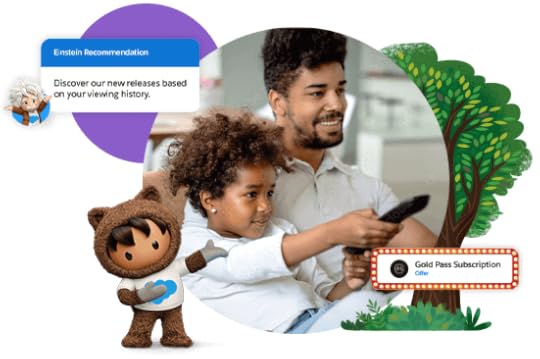
Offering a wide spectrum of choices on a technology platform equipped with the ability to serve up personalized recommendations can keep your customers consuming content on your service much longer. For example, if your gaming platform recognizes that a customer gravitates exclusively toward football titles, you can suggest similar titles on your platform that they haven’t yet tried to keep them engaged longer. For a music lover who can’t get enough of the 80s, your platform can recommend other artists from the era or serve up playlists curated with songs from that decade for your customer to stream non-stop. After all, content consumption is king.
Try something new or differentFinding inspiration from a different business sector can unlock new opportunities for media companies and help you win the streaming wars. Look at the travel industry. It’s full of many customers lured in by loyalty programs. They could be die-hard miles chasers or occasional travelers that largely remain loyal to one airline because they aim to earn perks that come with frequent ridership be they free checked bags, seat or cabin upgrades, or VIP status. Many in the media industry don’t offer loyalty programs, so there’s a prime opportunity to pioneer a new idea that can help drive increased engagement.
It’s tougher than ever to hold onto your subscribers In an increasingly crowded market, but the key is to deliver an unparalleled experience that makes it difficult for your customers to walk away. Investing in technology that can keep them happy by removing friction points and continuously serving up the content they’re seeking while surprising them with something new and different can go a long way in building loyalty and securing long-term subscriptions. Learn more about how technology can help you maximize subscribers’ lifetime value.
Alp Pekkocak leads industry and product marketing for Media & Entertainment at Salesforce. He works with media companies across the globe to drive digital transformation to address their needs for the constantly-evolving media landscape – from content production, distribution, monetization, to subscriber lifecycle management and audience engagement.
 For more articles from Shep Hyken and his guest contributors go to customerserviceblog.com.
For more articles from Shep Hyken and his guest contributors go to customerserviceblog.com.
Read Shep’s latest Forbes article: You Are A Subscription Business, Whether You Know It Or Not
The post Guest Post: 4 Ways Media Companies Can Keep Subscribers Engaged appeared first on Shep Hyken.



